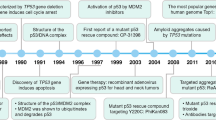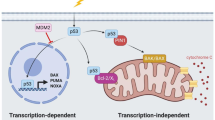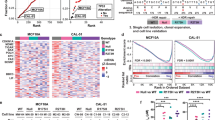Abstract
Malignant melanomas are frequently characterized by elevated levels of wild-type p53, suggesting that p53 function could be suppressed by a mechanism different from p53 mutation. We analysed the functionality of the p53-signaling pathway in a panel of seven human melanoma cell lines consisting of one p53-deficient line, two lines with mutant p53, and four lines expressing wild-type p53. Only lines with wild-type p53 were characterized by elevated levels of endogenous p21, high activity of p53-responsive reporters and accumulation of p53 in response to genotoxic stress, common properties of functional p53. The presence of wild-type p53 was associated with depletion or loss of p14ARF and p16 expression. The levels of p33ING1b and p24ING1c, two major products of Ing1 locus and putative coregulators of p53, were elevated in all cell lines tested; however, ectopic expression of either ING1 isoform had no effect on cell proliferation. All lines retained expression of Apaf-1, and all but one remained sensitive to ectopic expression of retrovirus-transduced p53. Our data indicate that regardless of abnormally high levels of p53 in melanomas, their p53 remains competent in transactivation of its targets, and, if highly overexpressed, capable of growth inhibition. Hence, the p53 pathway in malignant melanomas can be considered for pharmacological targeting and anticancer gene therapy.
This is a preview of subscription content, access via your institution
Access options
Subscribe to this journal
Receive 50 print issues and online access
$259.00 per year
only $5.18 per issue
Buy this article
- Purchase on SpringerLink
- Instant access to full article PDF
Prices may be subject to local taxes which are calculated during checkout




Similar content being viewed by others
References
Abarzua P, LoSardo JE, Gubler ML and Neri A . (1995). Cancer Res., 55, 3490–3494.
ACS (2002). Cancer Facts and Figures 2002. American Cancer Society: Atlanta.
Albino AP, Vidal MJ, McNutt NS, Shea CR, Prieto VG, Nanus DM, Palmer JM and Hayward NK . (1994). Melanoma Res., 4, 35–45.
Bae I, Smith ML, Sheikh MS, Zhan Q, Scudiero DA, Friend SH, O'Connor PM and Fornace Jr AJ . (1996). Cancer Res, 56, 840–847.
Bigner SH, Rasheed BK, Wiltshire R and McLendon RE . (1999). Neurooncol, 1, 52–60.
Birch JM, Blair V, Kelsey AM, Evans DG, Harris M, Tricker KJ and Varley JM . (1998). Oncogene, 17, 1061–1068.
Blagosklonny MV . (2000). FASEB J., 144, 1901–1907.
Campos Jr EI, Cheung KJ, Murray A, Li S and Li G . (2002). Br. J. Dermatol., 146, 574–580.
Cheung Jr KJ, Bush JA, Jia W and aand Li G . (2000). Br. J. Cancer, 83, 1468–1472.
Chin L, Merlino G and DePinho RA . (1998). Genes Dev., 12, 3467–3481.
Cirielli C, Riccioni T, Yang C, Pili R, Gloe T, Chang J, Inyaku K, Passaniti A and Capogrossi MC . (1995). Int. J. Cancer, 63, 673–679.
Donehower LA, Harvey M, Slagle BL, McArthur MJ, Montgomery Jr CA, Butel JS and Bradley A . (1992). Nature, 356, 215–221.
el-Deiry WS, Tokino T, Velculescu VE, Levy DB, Parsons R, Trent JM, Lin D, Mercer WE, Kinzler KW and Vogelstein B . (1993). Cell, 75, 817–825.
Gallion HH, Pieretti M, DePriest PD and van Nagell Jr JR . (1995). Cancer, 76, 1992–1997.
Garkavtsev I, Boland D, Mai J, Wilson H, Veillette C and Riabowol K . (1997). Hybridoma, 16, 537–540.
Garkavtsev I, Grigorian IA, Ossovskaya VS, Chernov MV, Chumakov PM and aand Gudkov AV . (1998). Nature, 391, 295–298.
Harvey DM and Levine AJ . (1991). Genes Dev., 5, 2375–2385.
Haupt Y, Maya R, Kazaz A and Oren M . (1997). Nature, 387, 296–299.
Hollstein M, Sidransky D, Vogelstein B and Harris CC . (1991). Science, 253, 49–53.
Hussussian CJ, Struewing JP, Goldstein AM, Higgins PA, Ally DS, Sheahan MD, Clark Jr WH, Tucker MA and Dracopoli NC . (1994). Nat Genet., 8, 15–21.
Kastan MB, Zhan Q, el-Deiry WS, Carrier F, Jacks T, Walsh WV, Plunkett BS, Vogelstein B and Fornace Jr AJ . (1992). Cell, 71, 587–597.
Kern SE, Kinzler KW, Bruskin A, Jarosz D, Friedman P, Prives C and Vogelstein B . (1991). Science, 252, 1708–1711.
Kichina J, Green A and Rauth S . (1996). Pigment Cell Res., 9, 85–91.
Leung KM, Po LS, Tsang FC, Siu WY, Lau A, Ho HT and Poon RY . (2002). Cancer Res., 62, 4890–4893.
Loggini B, Rinaldi I, Pingitore R, Cristofani R, Castagna M and Barachini P . (2001). Tumori, 87, 179–186.
Matlashewski GJ, Tuck S, Pim D, Lamb P, Schneider J and Crawford LV . (1987). Mol. Cell Biol., 7, 961–963.
Mehta RR, Bratescu L, Graves JM, Shilkaitis A, Green A, Mehta RG and Das Gupta TK . (2002). Melanoma Res., 12, 27–33.
Mietz JA, Unger T, Huibregtse JM and aand Howley PM . (1992). EMBO J., 11, 5013–5020.
Moll UM, Ostermeyer AG, Haladay R, Winkfield B, Frazier M and Zambetti G . (1996). Mol. Cell Biol., 16, 1126–1137.
Montano X, Shamsher M, Whitehead P, Dawson K and Newton J . (1994). Oncogene, 9, 1455–1459.
Mora PT, Chandrasekaran K, Hoffman JC and McFarland VW . (1982). Mol. Cell Biol., 2, 763–771.
Nouman GS, Angus B, Lunec J, Crosier S, Lodge A and Anderson JJ . (2002). Hybrid Hybridomics, 21, 1–10.
Olivier M, Eeles R, Hollstein M, Khan MA, Harris CC and Hainaut P . (2002). Hum Mutat, 19, 607–614.
Pear WS, Nolan GP, Scott ML and Baltimore D . (1993). Proc. Natl. Acad. Sci. USA, 90, 8392–8396.
Pomerantz J, Schreiber-Agus N, Liegeois NJ, Silverman A, Alland L, Chin L, Potes J, Chen K, Orlow I, Lee HW, Cordon-Cardo C and DePinho RA . (1998). Cell, 92, 713–723.
Ragnarsson-Olding BK, Karsberg S, Platz A and Ringborg UK . (2002). Melanoma Res., 12, 453–463.
Rass K, Gutwein P, Welter C, Meineke V, Tilgen W and Reichrath J . (2001). Histochem. J., 33, 459–467.
Rauth S and Davidson RL . (1993). Somat. Cell. Mol. Genet., 19, 285–293.
Rauth S, Green A, Bratescu L and Das Gupta TK . (1994a). In vitro Cell Dev. Biol. Anim., 30A, 79–84.
Rauth S, Kichina J, Green A, Bratescu L and Das Gupta TK . (1994b). Anticancer Res., 14, 2457–2463.
Renzing J and Lane DP . (1995). Oncogene, 10, 1865–1868.
Salti G, Kichina JV, Das Gupta TK, Uddin S, Bratescu L, Pezzuto JM, Mehta RG and Constantinou AI . (2001). Melanoma Res., 11, 99–104.
Soengas MS, Capodieci P, Polsky D, Mora J, Esteller M, Opitz-Araya X, McCombie R, Herman JG, Gerald WL, Lazebnik YA, Cordon-Cardo C and Lowe SW . (2001). Nature, 409, 207–211.
Soussi T and Beroud C . (2001). Nat. Rev. Cancer, 1, 233–240.
Sunamura M, Yatsuoka T, Motoi F, Duda DG, Kimura M, Abe T, Yokoyama T, Inoue H, Oonuma M, Takeda K and Matsuno S . (2002). J. Hepatobiliary Pancreat Surg., 9, 32–38.
Tannapfel A, Busse C, Weinans L, Benicke M, Katalinic A, Geissler F, Hauss J and Wittekind C . (2001). Oncogene, 20, 7104–7109.
Vogelstein B, Lane D and Levine AJ . (2000). Nature, 408, 307–310.
Wistuba II, Gazdar AF and Minna JD . (2001). Semin. Oncol., 28, 3–13.
Yamamoto M and Takahashi H . (1993). Virchows Arch. A Pathol. Anat. Histopathol., 422, 127–132.
Yew PR and Berk AJ . (1992). Nature, 357, 82–85.
Yin Y, Tainsky MA, Bischoff FZ, Strong LC and Wahl GM . (1992). Cell, 70, 937–948.
Zeremski M, Hill JE, Kwek SS, Grigorian IA, Gurova KV, Garkavtsev IV, Diatchenko L, Koonin EV and Gudkov AV . (1999). J. Biol. Chem., 274, 32172–32181.
Zhang Y, Xiong Y and Yarbrough WG . (1998). Cell, 92, 725–734.
Acknowledgements
This study was supported by grants from NIH CA75179 to AVG and grant from American Cancer Society to SR
Author information
Authors and Affiliations
Corresponding author
Rights and permissions
About this article
Cite this article
Kichina, J., Rauth, S., Das Gupta, T. et al. Melanoma cells can tolerate high levels of transcriptionally active endogenous p53 but are sensitive to retrovirus-transduced p53. Oncogene 22, 4911–4917 (2003). https://doi.org/10.1038/sj.onc.1206741
Received:
Revised:
Accepted:
Published:
Issue Date:
DOI: https://doi.org/10.1038/sj.onc.1206741



